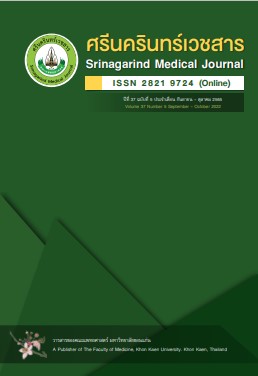ภาวะหัวใจเต้นช้ากว่าปกติจากการได้รับ 5-fluorouracil: กรณีศึกษา
5‐fluorouracil‐induced Bradycardia: A Case Report
Abstract
หลักการและวัตถุประสงค์: การเกิดภาวะแทรกซ้อนต่อหัวใจ เป็นอาการไม่พึงประสงค์หนึ่งที่พบได้จากการได้รับ 5-fluorouracil (5-FU) อาการทางคลินิกซึ่งสัมพันธ์กับการใช้ 5-FU ที่อาจพบได้ เช่น ภาวะเจ็บเค้นอก, ใจสั่น, อาการหายใจลำบาก, ภาวะกล้ามเนื้อหัวใจตาย, ภาวะช็อกจากเหตุหัวใจ และ ภาวะหัวใจหยุดเต้นเฉียบพลัน เป็นต้น แม้ว่าจะพบการเกิดความผิดปกติของคลื่นหัวใจโดยไม่มีอาการแสดง อย่างไรก็ตามภาวะหัวใจเต้นช้ากว่าปกติมักเป็นอาการที่มักไม่ถูกรายงาน รายงานกรณีศึกษานี้จึงมีวัตถุประสงค์เพื่อรายงานผู้ป่วยที่เกิดภาวะหัวใจเต้นช้ากว่าปกติโดยไม่มีอาการแสดงจากการได้รับการรักษาด้วย 5-FU
กรณีศึกษา: ผู้ป่วยหญิงอายุ 47 ปีซึ่งมีโรคประจำตัวเป็นโรคหัวใจที่มีโครงสร้างหัวใจผิดปกติ ได้รับการวินิจฉัยว่าเป็นมะเร็งเยื่อบุโพรงมดลูกระยะ 4B เมื่อ 9 เดือนที่ผ่านมา โรคหัวใจของผู้ป่วยซึ่งได้รับการตรวจก่อนให้การรักษาด้วยยาเคมีบำบัดอยู่ในภาวะคงที่ อย่างไรก็ตามในวันที่ 3 ของการให้ยาเคมีบำบัดแบบประคับประคอง (รอบที่ 1) ด้วย 5-FU ขนาด 1000 มิลลิกรัม/ตารางเมตร ผู้ป่วยได้เกิดภาวะหัวใจเต้นช้ากว่าปกติโดยไม่มีอาการแสดง ซึ่งหลังจากเกิดเหตุการณ์ดังกล่าว ได้มีการหยุดยา 5-FU และไม่มีการให้ยาดังกล่าวอีก
สรุป: การเกิดภาวะหัวใจเต้นช้ากว่าปกติจาก 5-FU ถือเป็นอาการไม่พึงประสงค์ต่อหัวใจที่พบได้ไม่บ่อยนัก ผู้ป่วยที่มีโรคประจำตัวเป็นโรคหัวใจ ควรได้รับการประเมินโรคและปัจจัยเสี่ยงของการเกิดโรคหัวใจและหลอดเลือดก่อนเริ่มการรักษา นอกจากนี้การติดตามผู้ป่วยอย่างใกล้ชิดด้วยการตรวจคลื่นไฟฟ้าหรือการติดเครื่องบันทึกคลื่นไฟฟ้าหัวใจแบบพกพาก็มีความจำเป็นเช่นกัน เมื่อเกิดเหตุการณ์ดังกล่าวควรหยุด 5-FU ทันที การให้ยา 5-FU แก่ผู้ป่วยอีกครั้งสามารถทำได้ในผู้ป่วยบางรายที่มีอาการไม่รุนแรงเท่านั้น อย่างไรก็ตามควรมีการประเมินความเสี่ยงกับประโยชน์ที่ได้รับก่อนทำการให้ยาอีกครั้ง
คำสำคัญ 5-Fluorouracil, ยากลุ่มต้านเมแทบอไลต์, ยาเคมีบำบัด, ความเป็นพิษต่อหัวใจ, ภาวะหัวใจเต้นช้ากว่าปกติ
Background and Objective: Cardiotoxicity is one of the adverse effects associated with 5-fluorouracil (5-FU) based regimen. Diverse abnormal clinical manifestations such as angina, palpitation, dyspnea, myocardial infarction, cardiogenic shock and cardiac arrest have been linked to 5-FU. Although asymptomatic electrocardiogram (ECG) abnormalities were presented, the identify of bradycardia was rarely reported. This case report aimed to describe the case of asymptomatic bradycardia after receiving 5-FU treatment.
Case presentation: We report a case of 47-year-old female who was previously diagnosed with mucinous adenocarcinoma of cervix clinical stage IVB 9 months and had a history of structural heart disease. Her cardiac condition, which was investigated before chemotherapy treatment, showed stable disease. However, during 5-FU palliative chemotherapy (Cycle 1), she developed asymptomatic bradycardia on the third day of cycle with 5-FU 1000 mg/m2. After occurrence of the cardiac event, 5-FU was discontinued, and reintroduction of 5-FU was not performed.
Conclusion: 5-FU induced bradycardia is an unusual cardiac event. In patients with history of cardiovascular disease, evaluating cardiac disease and cardiovascular risks should be performed before treatment initiation. Moreover, close monitoring with ECG or a 12-leads Holter monitoring are necessary as well. 5-FU should be immediate discontinued after the event is suspected. Reintroduction of 5-FU could be performed in some patients without serious problems. However, risk-benefit assessment should be done before performing rechallenge therapy.
Keywords: 5-Fluorouracil, antimetabolite, chemotherapy, cardiotoxicity, bradycardia


